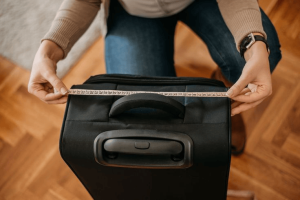How to Measure a Suitcase
Measuring a suitcase is a straightforward process, and you’ll typically need a simple tape measure or a ruler. Here are the steps to measure a suitcase:
Open the Suitcase: Unzip or unlock your suitcase and open it up fully. Ensure that it’s empty, so you get an accurate measurement.
Select a Flat Surface: Place the suitcase on a flat and even surface. This ensures that you get an accurate measurement.
- Length, Width, and Height:
- Length: Measure from the bottom of the suitcase (where it rests on the ground) to the very top, following the curve of the suitcase. This is the longest dimension.
- Width: Measure from side to side, usually across the front of the suitcase. This is the width.
- Height: Measure from the bottom of the suitcase to the top, but this time measure the height from side to side. This is the height.
Measure in Inches or Centimeters: You can measure in either inches or centimeters, but make sure to be consistent with your units.
Record the Measurements: Write down or remember the measurements for each dimension (length, width, and height).
Overall Size: If you need to know the overall size of your suitcase, simply add the three measurements together. The sum will give you the overall size, often referred to as the linear inches or linear centimeters.
Confirm Any Specific Rules: If you’re measuring the suitcase for airline travel, make sure to check the specific baggage size restrictions for the airline you plan to fly with, as different airlines have different size limits for checked and carry-on luggage.
Double-Check Your Measurements: It’s a good practice to double-check your measurements to ensure accuracy.
Keep in mind that when airlines provide size restrictions for luggage, they often specify the maximum dimensions allowed for both carry-on and checked baggage. If your suitcase is close to the limits, it’s a good idea to measure it to make sure it complies with the airline’s regulations. Also, read about Rugs in the Kitchen
Understanding the Importance of Measuring a Suitcase
Measuring your suitcase might seem like a mundane task, but it’s essential for several reasons. Airlines have strict regulations regarding luggage size, and if your suitcase exceeds their limits, you could face extra charges or inconveniences. Knowing your suitcase’s dimensions also helps you make efficient packing choices and ensures your luggage fits comfortably in various travel scenarios.
The Tools You’ll Need
Before you start measuring your suitcase, gather the necessary tools:
- A tape measure or ruler
- A flat surface
- A pen and paper
Measure the Length
- Lay your suitcase flat on its back on a level surface.
- Use the tape measure or ruler to measure the length from the bottom of the suitcase to the top, along the longest side.
- Record this measurement.
Measure the Width
- Keep the suitcase on a flat surface.
- Measure the width by running the tape measure or ruler from one side of the suitcase to the other.
- Note down this measurement.
Measure the Depth
- Now, measure the depth by placing the tape measure or ruler from the front of the suitcase to the back.
- Write down this measurement.
Calculate the Total Volume
To find the total volume of your suitcase, multiply the length, width, and depth measurements:
Total Volume = Length x Width x Depth
Understanding your suitcase’s total volume is valuable when comparing it to airline regulations.
Understanding Airlines’ Luggage Regulations
Airlines have varying luggage size restrictions, so it’s crucial to check with your specific airline. Most carriers have a limit for both checked and carry-on luggage. By measuring your suitcase accurately, you can ensure it complies with your chosen airline’s regulations. For more interesting information visit our website briefbeats.com

Choosing the Right Suitcase Size
Knowing your suitcase’s dimensions allows you to make an informed decision when purchasing a new one. Consider your travel needs and the airline you frequently use. A suitcase that fits comfortably within their size restrictions is an excellent choice.
Tips for Accurate Measurement
-
- Ensure your suitcase is empty before measuring it.
- Use a tape measure or ruler with clear markings.
- Take measurements in centimeters for international travel, or inches for domestic travel.
- Double-check your measurements to ensure accuracy.
Considerations for Irregularly Shaped Suitcases
If you have a suitcase with irregular shapes, like those with wheels or handles, measure from the farthest point on each dimension for accuracy.
Benefits of Proper Measurement
Accurate measurements offer several benefits:
- Avoiding extra baggage fees.
- Efficient packing and space utilization.
- Ensuring your suitcase fits in overhead compartments.

Packing Efficiently
Knowing your suitcase’s size helps you make efficient packing choices. Use packing cubes, roll your clothes, and make use of every inch of space to optimize your luggage.
Conclusion
Measuring a suitcase is a simple yet essential task for any traveler. It ensures you adhere to airline regulations, pick the right suitcase, and maximize packing efficiency. By following the steps outlined in this guide, you can travel stress-free with a suitcase that suits your needs.
FAQs
Do all airlines have the same luggage size restrictions?
No, airline luggage size restrictions vary, so it’s essential to check with your specific airline.
What if my suitcase exceeds the airline’s size limit?
If your suitcase is too large, you may incur extra baggage fees or need to check it separately.
Can I measure my suitcase in inches for international travel?
It’s recommended to measure in centimeters for international travel as most countries use the metric system.
How can I maximize packing efficiency after measuring my suitcase?
Use packing cubes, roll your clothes, and make use of every available space within your suitcase.
What’s the best way to measure irregularly shaped suitcases?
Measure from the farthest point on each dimension, such as handles or wheels, for accuracy.
